Beneath the surface: What’s new in the quarrying and mining industry?
15 August 2023
Equipment sales have been strong globally for the quarrying and mining sector as the industry juggles this with integrating new technology and power options, reports Andy Brown.
Business has been good in the quarrying and mining segment; according to industry experts the Parker Bay Company, the first quarter of the year saw reported shipments increase on a dollar weight basis by 6.7%. The company added that shipments of relatively lower-priced wheeled loaders, dozers and truck shipments declined slightly, but were offset by high-value hydraulic shovels/excavators with unit deliveries up by more than 50% with aggregate valuation up nearly 70% owing to a surge in the largest units.
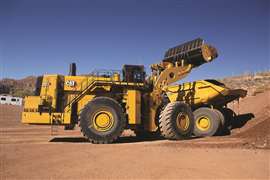 Integrated with electronics, the new Cat 995 Wheel Loader is said to offer flexible levels of information and technologies for a smart machine and more informed operator (Photo: Caterpillar)
Integrated with electronics, the new Cat 995 Wheel Loader is said to offer flexible levels of information and technologies for a smart machine and more informed operator (Photo: Caterpillar)
In an exclusive interview given to International Construction’s website earlier this year, the Managing Director of articulated truck manufacturer Rokbak, Paul Douglas, noted that the last 18 months have been a boom time for both rigid and articulated haulers with numbers the highest they have been for around a decade at around 9,000 units a year.
Part of this is due to pent up demand that followed the Covid-19 pandemic, added to governments around the world investing in large infrastructure projects, although Douglas believes that this is likely the peak of the market.
“We all felt at 8,000 units worldwide, that would be the peak. Then we said the same thing at 8,500, but now we are over 9,000 units,” he says. “When I look around specific markets, we can see the slowdown coming, such as in Europe. I think we’re probably at the peak now. How long will that hold? Most of 2023 will probably level out [at current levels] although we could start to see a downturn in the second half of the year. It’s very strong at the moment, so we need to capitalise on that as much as we can.”
One of the markets that has driven this growth is North America, which Douglas says accounts for over half of Rokbak’s sales. In terms of smaller markets that have seen good growth, he highlights Indonesia and the UK where the HS2 high-speed train project has played a key role in generating demand.
Market trends in quarrying and mining
“The biggest trends in the quarry and mining sectors are very similar to those we see in our everyday lives. There is a heavy focus on digitising, connecting, tracking and monitoring equipment, production, fuel and other important metrics,” says Craig McGinnis, Sr. Business Solutions Manager, Smart Quarry, Komatsu.
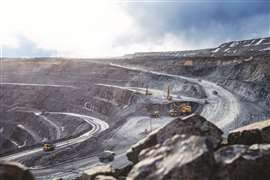 Quarrying and mining equipment sales have been at a high level in recent years
Quarrying and mining equipment sales have been at a high level in recent years
“Another major trend is the renewed – and even increased – focus on the bottom line. This drives customers to look for efficiencies. While fleet composition has always been important, and still is, we see our customers doing a deeper dive, looking beyond just the size and quantity of machines in their fleet to things like production, idle time, efficiency and utilisation.”
Reinforcing the strong sales in the sector is the news that China-based XCMG has delivered its first batch of large-scale complete mining equipment, worth more than US$14.4 million, including its 90-ton to125-ton mining excavators and 80-ton to 90-ton mining cars to several global markets.
These markets are predominantly in countries in Southeast and Central Asia, and Africa – markets that are traditionally strong for Chinese OEMs.
XCMG’s 125-ton mining excavators have a standard 7.7m³ bucket, meaning that they can fill a 100-ton mining car with only five or six buckets. Independently developed by the OEM, its control system are said to be able to achieve the optimal output of main pump and engine power according to the operation requirements, to reach the best fuel consumption ratio.
To take advantage of the strength of the global mining equipment industry XCMG says that it offers a one-to-one on-site service to the global mine managers, including a 24-hour follow-up service after purchase and full-cycle maintenance and management assistance.
“XCMG’s, high-end, large-tonnage mining machinery products have brought new business opportunities in the beginning of 2023. We hope to propel the green transformation of the entire industry through sustainable development solutions, and lead the way in equipment technology and operation management,” said Cui Jisheng, Assistant President of XCMG and General Manager of XCMG Mining Machinery.
New and updated models of mining equipment
Hitachi has launched its next generation of Zaxis-7 large excavators, the new ZX490LCH-7, ZX530LCH-7, ZX690LCH-7 and ZX890LCH-7 Stage-V compliant models. The OEM says that they provide fuel savings of up to 20% (PWR mode) compared to previous models, achieved through a HIOS-V hydraulic system. This also enhances efficiency in the swing, boom lowering and arm bucket roll-out.
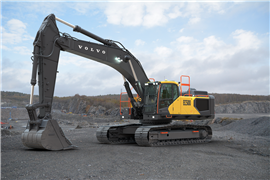 Volvo CE’s EC500 – the OEM says it is the next generation of faster, safer and more productive excavators (Photo: Volvo CE)
Volvo CE’s EC500 – the OEM says it is the next generation of faster, safer and more productive excavators (Photo: Volvo CE)
Productivity is said to be increased by the improved front speed for loading operations, while the increased engine output of the new machines contributes to a higher workload.
The fuel efficiency of Zaxis-7 large excavators can also be controlled by using the new ECO gauge, clearly visible on the cab’s monitor. Besides reducing costs, better fuel economy has a positive impact on environmental performance. The new machines are Stage V-compliant thanks to the combination of the SCR (selective catalytic reduction) system, DOC (diesel oxidation catalyst) and CSF (catalysed soot filter).
The OEM says that the ZX690LCR-7 and ZX890LCR-7 models are built with reinforced parts that are ideal for the digging and loading of heavy materials and are strengthened to cope with the rigours of mining and quarrying.
“We’re proud to present the latest range of Hitachi large excavators to our European customers,” says Hitachi Construction Machinery (Europe) NV President Makoto Yamazawa.
“Hitachi has continuously improved on previous generation machines to enhance the operator’s experience in the cab, to meet the needs of owners.”
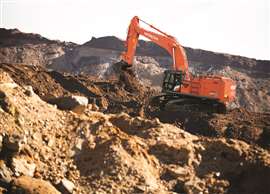 Hitachi has launched its next generation of Zaxis-7 large excavators (Photo: Hitachi)
Hitachi has launched its next generation of Zaxis-7 large excavators (Photo: Hitachi)
Caterpillar says that it is building on the success of the 994K wheeled loader with the new 995. It is reported to feature up to 19% increased productivity than the previous model with its higher rated payload and a 6% increase in hydraulic force with equal hydraulic cycle time.
The OEM says that this new loader delivers up to 13% lower hourly fuel consumption and offers up to an additional 8% efficiency gain when operating in Enhanced Eco Mode compared to throttle lock mode.
Enhancements to the front linkage include an improved casting design, increased weld size, larger bearings and pins, and profile changes for increased service life. New, larger capacity buckets available for the 995 incorporate an extended floor for fast loading, high fill factors reaching 115%, and excellent material retention. Buckets are interchangeable between the 995 and 994K.
Built to the same size as the 994K but offering a higher-rated payload, the new 995 enables a one-pass reduction when loading Cat 785, 789 and 793 Mining Trucks.
The new 995 has a Cat 3516E engine offering configurations based on regional needs, meeting EU Stage V/U.S. EPA Tier 4 Final or US. EPA Tier 1 equivalent emissions.
What technological innovations have there been in quarrying and mining?
In many aspects, when it comes to the use of new technology, quarrying and mining has been ahead of the general construction industry. Take, for example, the case of automation: this is well established in the industry to the extent that last year Caterpillar announced that it had hauled autonomously more than one billion tonnes of material.
Due to work often taking place at mines and quarries for years, or even decades, electric equipment is not uncommon as it makes financial sense to build charging infrastructure for a long-term project. However, what might be a new sight in the next few years is a large electric excavator, with Volvo Construction Equipment (Volvo CE) earlier this year unveiling the EC500 crawler excavator – a 50 tonne prototype machine designed for heavy applications such as quarrying.
The company says the new machine – which will be made available in regulated markets including Europe and North America – heralds its next generation of large machines, being faster, safer and more productive than predecessor models.
 Komatsu says that in quarrying and mining there is a real focus on digitisation and tracking and monitoring key metrics (Photo: Komatsu)
Komatsu says that in quarrying and mining there is a real focus on digitisation and tracking and monitoring key metrics (Photo: Komatsu)
The EC500 (successor to the EC480E) boasts a new cab layout, with features including a high-definition co-pilot screen, keyless engine start, wired and wireless smart phone charging and a new work mode switch.
The technology on board the new excavator includes Volvo Smart View with Obstacle Detection. With a combination of enhanced cameras and radar detection, the system gives operators a 360-degree view, as well as delivering alerts when objects are detected, also identifying and classifying them as human.
The excavator’s hydraulic pumps can be operated together as well as virtually disconnected, allowing the operator to control the boom without affecting track speed. This, says Volvo, increases controllability, shortens cycle times and improves fuel efficiency, which has the potential to deliver higher productivity and performance.
Stephen Roy, president of Volvo CE North America, said, “A pre-production model, there will be some differences to the appearance of the EC500 that will be available to our customers, but it gives an insight into the future, with enhanced safety, operability and productivity.” Production of the EC500 is expected to begin in the fourth quarter of 2023.
Sustainability in construction
Komatsu’s Craig McGinnis reveals that sustainability is an increasingly important topic of conversation for the majority of customers. “We’re hearing more customers ask about sustainability and ESR (Environmental Social Responsibility) initiatives than ever before,” he comments.
“Starting with fleet composition, if you are running the ideal quantity and correct size machines for a given operation, this is a big step towards sustainability goals. Why run bigger machines that burn more fuel if you don’t need to?
“Komatsu’s Smart Quarry Study service helps customers answer this question about ‘right-sizing’ machines by taking a close look at their objectives, their equipment and finding that sweet spot that balances efficiency and productivity. Solutions such as Smart Quarry Site, help customers dial in that fleet so they know it’s being used most efficiently.”
McGinnis added that Komatsu has two excavators suitable at quarries – the PC3000 and ultra-class PC4000 – that are also offered as electric options.
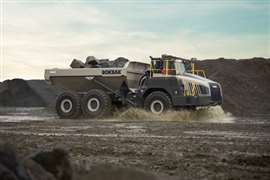 Rokbak equipment comes two sizes: with payloads of 28 and 38 metric tonnes
Rokbak equipment comes two sizes: with payloads of 28 and 38 metric tonnes
For the final word on the subject, we return to Rokbak’s Douglas who says that, even though it is harder for the larger equipment used in quarrying and mining to have zero emissions this change has to – and will – happen. “The question is: what does that look like? Electrification using battery technology that you can see today is a stretch for these big products because these are big power demands for long hours of usage,” he comments.
As Douglas says, electric power probably isn’t the best source for trucks due to how large they are and their work cycles – it isn’t uncommon for trucks to run for 20 or 22 hours a day. “We are looking at hydrogen internal combustion engine and fuel cells to provide the electricity using hydrogen,” he reveals.
The technology in the alternative power segment is moving extremely quickly and there is little doubt that, in the next few years, an increasing amount of the large and powerful machinery used in this specialist segment will be powered very differently to how it has been in the past.
Smart drilling
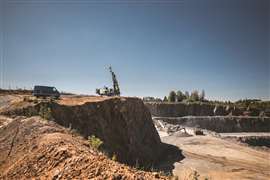 The new Epiroc drill rigs have reduced fuel consumption (Photo: Epiroc)
The new Epiroc drill rigs have reduced fuel consumption (Photo: Epiroc)
A surface drilling team in the Czech Republic is successfully providing drill and blast services to quarries across the country after purchasing a new fleet of Epiroc equipment. Some years ago, the Fospol division of Explosia made the decision to renew its fleet and has since been continually phasing out its older drill rigs and replacing them with modern equipment.
The company currently has six drill rigs, three of which are from Epiroc, including the top-of-the-range SmartROC D50 MKII, and is aiming to boost its capacity to five Epiroc rigs by year-end 2023.
Both of these SmartROC T40 MKII rigs are equipped with the Hole Navigation System (HNS) and are expected to be delivered in the second half of 2023.
In addition, the whole fleet will be backed up by Epiroc’s ROC Care service and maintenance contract which includes regular service inspections using the company’s RigScan scanning technology.
Moving four million tonnes of nickel
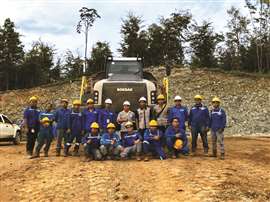
On an island on the edge of the Pacific Ocean, 2000km north-east of Java, a trio of Rokbak RA40s operate across a 45,065-hectare mining site. At this remote location in North Maluku, Indonesia, the Rokbak articulated haulers operate up and down steep inclines, through mud, dirt, grit and gravel, for close to 24 hours a day, at the mercy of the Southeast Asian elements.
Required to move around 450 tonnes of biomass and quarry materials in a single day, each RA40 will record approximately 6,000 operating hours per year. The haulers are tasked with removing overburden and providing mine development support for the acquisition of high-demand nickel, the harder-than-iron metal used in some form in practically every aspect of day-to-day life. Every full-capacity payload sees each RA40 transport overburden two-kilometres to a project access road and biomass dump for disposal.
The site is run by PT Hillcon, a significant name in the construction, mining, property and heavy equipment industries in Indonesia. Its current occupation in the nickel deposit of North Maluku is a five-year process that began in September 2021. It will last until Q4 2026, by which time it will have produced an estimated four million tonnes of nickel.
STAY CONNECTED



Receive the information you need when you need it through our world-leading magazines, newsletters and daily briefings.
CONNECT WITH THE TEAM








